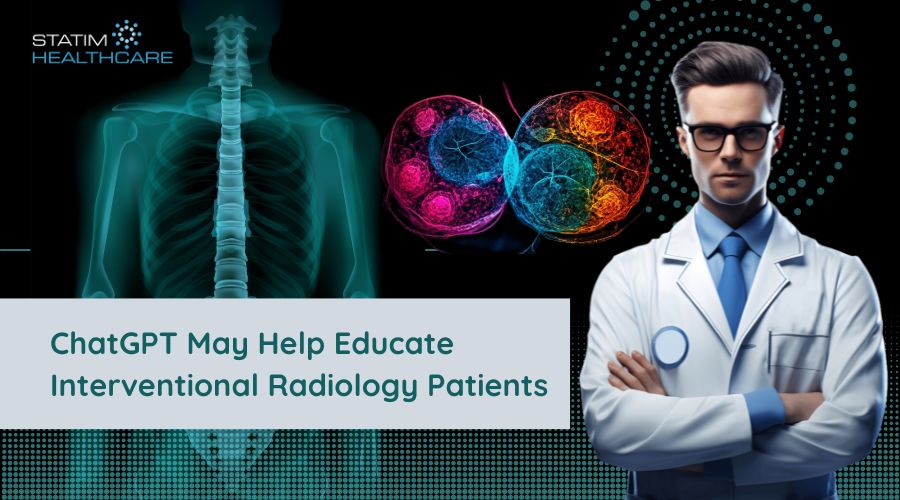Interventional radiology plays a role in the diagnosis and treatment of medical conditions using advanced medical imaging techniques. Patient education is crucial for ensuring outcomes, and the integration of cutting-edge technologies like ChatGPT offers potential in this field. In the United States, where medical advancements are embraced, ChatGPT has emerged as an accurate tool for educating radiology patients. A recent study published in CardioVascular and Interventional Radiology highlights the advantages of incorporating ChatGPT into education. By generating content and facilitating communication, ChatGPT helps healthcare providers educate patients about their medical imaging radiology procedures, empowering them to make well-informed decisions about their care.
Understanding Interventional Radiology
Interventional radiology is a field of medical imaging that deals with both diagnosing and treating various diseases and conditions. This branch of radiology employs techniques to access and address specific areas of the body. Interventional radiology services in USA is the most extensive recognized practice involving trained doctors who have completed a rigorous residency program in radiology and have obtained board certification.
The procedures performed by radiologists involve the use of instruments like catheters or wires, which are inserted into the body through small incisions or natural body openings. These instruments are guided by imaging technologies such as X-rays, CT scans, and ultrasound, allowing the radiologist to visualize and navigate through the body. This enables them to carry out a range of procedures, including angiography, angioplasty, embolization, foreign object removal, and needle biopsy, among others.
The Essential Role of Patient Education in Interventional Radiology
Patient education plays a role within the field of radiology (IR) as it empowers patients to make well-informed decisions about their healthcare and actively participate in their treatment plans. The primary objective of education in IR is to equip individuals with the knowledge and understanding of their condition, the proposed interventional procedures, and the potential risks and benefits associated with them.
By educating patients, interventional radiologists can enhance communication and build trust, ensuring that patients have an understanding of their options and are actively involved in the decision-making process. This approach helps align expectations with the realities of procedures, ultimately leading to improved treatment outcomes and increased patient satisfaction.
Patient education within IR encompasses methods such as employing teaching techniques, providing online resources, and facilitating personalized discussions with healthcare professionals. These approaches aim to simplify concepts, promote better comprehension among patients, and address any concerns or misconceptions they may have. By engaging patients in their healthcare journey, interventional radiologists foster a patient-centered approach to care.
Introduction to ChatGPT
ChatGPT, developed by OpenAI, is an AI language model that stands out for its understanding of spoken and written language, including humor. What sets it apart is its structure, which enables a grasp of the subtleties of language, surpassing other tools in this respect. One notable feature is its ability to retain context during conversations, greatly enhancing its capabilities. Although ChatGPT may offer only some of the functionalities of search engines, it serves as a starting point for research. It can be a helpful tool to overcome writer’s block. This robust language model has possibilities ranging from language translation to writing, transforming communication and interaction. While some editing may still be required, ChatGPT undeniably represents a breakthrough in artificial intelligence.
How ChatGPT Can Educate Interventional Radiology Patients?
–ChatGPT offers learning opportunities for patients undergoing radiology procedures.
–It allows patients to learn at their own pace through self-paced learning. ChatGPT serves as a platform for patients to revise and reinforce their knowledge.
–It supports educators in creating scenarios specifically designed for interventional radiology patient education purposes.
–With ChatGPT, educators can develop assessments to evaluate patients’ understanding.
–It promotes group collaboration by facilitating learning and discussions among patients.
–ChatGPT can be employed for research activities in interventional radiology education.
Future Implications and Possibilities of AI in Interventional Radiology Services

AI combined with Augmented Reality/Virtual Reality can potentially help teleradiology interpretation services regarding diagnosis, planning, and treatment management. It can aid in faster and more accurate decision-making, earlier disease identification, and cost-effective solutions. AI can also measure treatment response and prognostication and determine future management. While the article does not explicitly mention the implications and possibilities of AI in interventional radiology services in USA, it highlights the potential benefits of AI in radiology.
How AI combined with Augmented Reality/Virtual Reality Enhance teleradiology interpretation services?
–Integrating AI and Augmented Reality/Virtual Reality (AR/VR) can enhance teleradiology interpretation services, improving the efficiency and accuracy of diagnoses and treatment planning.
–When AI and AR/VR technologies are combined, radiologists are offered an interactive experience. They can now visualize images in 3D. Manipulate them in real time, adding depth to their analysis.
–AI algorithms play a role by analyzing images automatically. This assistance helps radiologists detect abnormalities, identify patterns, and confidently diagnose.
–AR allows content, like annotations or additional information, to be superimposed onto world medical images. This contextual information enhances the understanding of these images for radiologists.
–On the other hand, VR creates environments that simulate realistic medical scenarios. Radiologists can practice their skills, collaborate remotely with experts from different locations, and receive training in a controlled environment.
–By combining AI with AR/VR technology in teleradiology interpretation services, we can expect improvements in speed, accuracy, and collaboration among professionals. Ultimately, this leads to patient care and outcomes.
Choose Statim Healthcare for Accurate Teleradiology Interpretation Services
As one of the leading outsourcing teleradiology interpretation services in the USA, Statim Healthcare provides accurate and timely interpretations of radiology images. Our team of experienced radiologists guarantees the highest quality services. We understand the importance of meeting your needs and offer tailored solutions and round-the-clock support. Trust Statim Healthcare for effective teleradiology interpretation services. Get in touch with us today to find out more.

